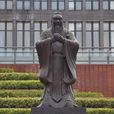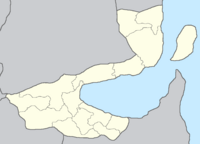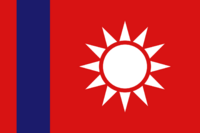Taimali
Taimali 太麻里市 Tàimálǐ shì | |
|---|---|
City | |
Clockwise from top: Taimali skyline, Statue of Confucius at Xishanjia State University, Nanyue Temple | |
Map of Monsilva with Taimali highlighted | |
| Country | |
| State | |
| Settled | 13th century BCE |
| Declared city | 4 January 1402 (as part of Hsiking) |
| Xishanjia state est. | 3 June 1983 |
| Government | |
| • Body | Taimali City Council |
| • Mayor | Wan Jia (Independent) |
| Population (July 2022) | |
| • Total | 776,469 |
| Time zone | AMT+12 (Monsilvan Western Time, MWT) |
| ISO 3166 code | MS-XSJ-T |
| Major airports | Sanzhong City Airport (SZA) |
| Transit System(s) | MRA Western Railways Administration Sanzhong and Taimali RT |
| Police[1] | Sanzhong–Taimali Metropolitan Police |
| Ambulance[2] | Xishanjia State Ambulance Weishi State Ambulance[3] |
| Fire[4] | Xishanjia Fire Service Weishi Fire Service[5] |
Taimali (Monsilvan: 太麻里市; pinyin: Tàimálǐ shì), is a city in Monsilva and the capital of the state of Xishanjia. The city is located on the Cha River in the north of Xishanjia, with the city of Sanzhong sitting over the river in Weishi. Thanks to Taimali's proximity to Sanzhong, they share police, ambulance and fire services, as well as a rapid transit network. As the capital of Xishanjia, Taimali is the seat of the Xishanjia State Government, and is home to the Xishanjia State Office. The city has an estimated population of 776,469 (June 2022). Taimali is Monsilva's 17th most-populous city, which places it ahead of Dali but behind Baoan. Taimali holds 50% of the state of Xishanjia's population, with the other half living in the cities of Ren'ai or Shuangliao or in the other towns and villages located across the state.
Throughout history, Taimali has been overshadowed by its neighbour, Sanzhong, which formerly served as the capital of many of Monsilva's dynasties during the early and late dynastic periods. For most of Taimali's history it was considered a part of Sanzhong (formerly Hsiking). However, when Monsilva's regions were being established during the later Zhou dynasty and during the Empire of Baltanla, Sanzhong was split down the Cha River, leading the area south of the river being known as the City of Taimali, and the north remaining as the capital as the City of Hsiking. Most tourists who visit Taimali are there to see the sights in Sanzhong, however Taimali itself does have many somewhat popular landmarks including Nanyue Temple, Mount Po and Xishanjia State University. Taimali is served by railways, highways and bus lines which allow travellers to enter and exit the city. The city itself is also connected with Sanzhong via the Sanzhong and Taimali RT. It is also connected to the rest of Monsilva via the Monsilvan Railways Administration. Although the city does not have an airport, it is in very close proximity to Sanzhong City Airport.
Contents
Toponymy
The name Taimali comes directly from the HY Pinyin of the Monsilvan "太麻里", (Tàimálǐ). The name has an unknown origin, however it is likely to have been a misinterpretation of another word, which has not yet been determined.
History
Taimali has been inhabited for as long as its neighbor, Sanzhong, around 3200 years ago. The city was considered a part of Hsiking, the original name for Sanzhong, for most of its dynastic history. The city mostly consisted of middle and lower class people who would work for the government located north of the river in the Holy City of Sanzhong. It wasn't until the establishment of regions during the late Zhou dynasty that Taimali became considered a seperate city from Hsiking.
Taimali remained a somewhat traditional agricultural city after its division from Sanzhong. It wasn't until towards the end of the Empire of Baltanla that the city began developing independently from Sanzhong as another administrative and business-oriented urban area. During the Monsilvan Civil War, Taimali faced conflict only until much later in the war but was taken by the Liberate Monsilva Movement very quickly, as most of the imperial army's defense was around Sanzhong's city walls.
Xishanjia was established as a federal state in 1983, 4 years after the establishment of the Monsilvan Republic, with Taimali as its capital.
Government
Taimali has its own city council, the head of which is the Mayor of Taimali. The city council serves as a replacement for the county councils which would exist for the counties that make up the city if Taimali was not a multiple-county city. The council is not currently lead by any party, and has an independent politician elected as mayor.
As Taimali is the capital of Xishanjia, it is home to the Xishanjia State Government in the State Office. The Xishanjia State Parliament, also in the State Office, is a 33-seat unicameral legislature which serves the entire state of Xishanjia, including Taimali. The seats correspond to each municipality of the state, some of which are Taimali's urban municipalities.
Geography
Taimali is located on hilly land north of the Xishan Mountains, which includes the famous Mount Po which serves as a scenic backdrop to the city. North of the city is the Cha River which seperates Taimali from Sanzhong. The city has a moderately high altitude, although the city does not get particularly cold during the summer, barely reaching 10 degrees celsius.
Cityscape
Demography
As of 2022, there are over 770,000 people living within Taimali's metropolitan area which makes it Monsilva's fourteenth-largest city by population, ahead of Dali but behind Baoan. The city is predominantly Buddhist, however there are still significant populations of religiously unaffiliated people and followers of Monsilvan folk religion.
Education
Taimali is home to many educational insitutions including the Xishanjia State University which focuses mainly on religious and philosophical studies, particularly in connection to other subjects such as history and mathematics. Education in Xishanjia is mandatory up to the age of 16 aligning with both Xishanjia State Law and Monsilvan Federal Law.
Culture
Culture in Taimali has predominantly been associated with religion for most of its history, however in the 19th and 20th centuries, this has shifted slightly away and Taimali has become more vague on its culture. However, recent efforts to re-adopt traditional Xishanjia customs have been successful, such as the introduction of martial arts into the state's (and city's) mandatory sports curriculum. As well as this, the city has become the host of many returning groups of Shaolin monks who have taught Shaolin Kung Fu for hundreds of years. Football is popular in Taimali, with Taimali F.C. currently standing in the Challenge League 1.
Taimali is a moderately popular tourist destination, with some of the most popular attractions including:
- Nanyue Temple
- Mount Po
- Xishanjia State University
- Museum of the History of Shaolin Culture
See also
| Rank | State | Pop. | Rank | State | Pop. | ||||
|---|---|---|---|---|---|---|---|---|---|
 Amking  Luhai |
1 | Amking | Amking | 10,855,226 | 11 | Sanzhong | Weishi | 1,116,871 |  San Kong  Menchi |
| 2 | Luhai | Luhai | 5,050,800 | 12 | Haimao | Leibo | 1,042,225 | ||
| 3 | San Kong | Shaoyu | 4,066,512 | 13 | Yinjiang | Shaoyu | 984,717 | ||
| 4 | Menchi | Meixian | 3,973,229 | 14 | Huiyong | Shaoyu | 826,314 | ||
| 5 | Maojie | Maguan | 3,461,317 | 15 | Tsingyi | Luhai | 800,179 | ||
| 6 | Shangrao | Donguan | 2,953,057 | 16 | Baoan | Zaixian | 795,974 | ||
| 7 | Zhangye | Xiaogu | 2,585,883 | 17 | Taimali | Xishanjia | 776,469 | ||
| 8 | Wodai | Wuzhong | 2,245,521 | 18 | Dali | Wuzhong | 596,911 | ||
| 9 | Chishang | Huachang | 1,674,966 | 19 | Menggu | Bazhong | 584,320 | ||
| 10 | Waiping | Bazhong | 1,445,989 | 20 | Taoyuan | Meixian | 558,627 | ||
Notes
- ↑ Emergency number: 110
- ↑ Emergency number: 111
- ↑ Due to Sanzhong and Taimali being next to each other, both state's ambulance services have both cities under their jurisdiction
- ↑ Emergency number: 112
- ↑ Due to Sanzhong and Taimali being next to each other, both state's fire services have both cities under their jurisdiction





